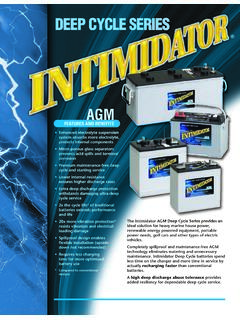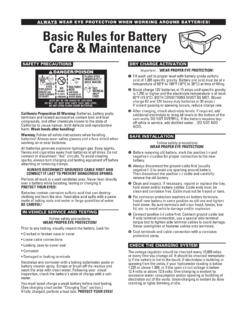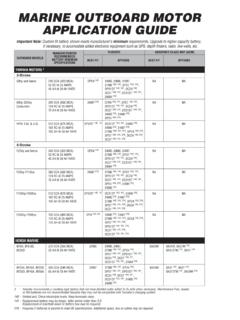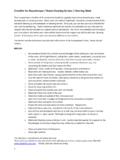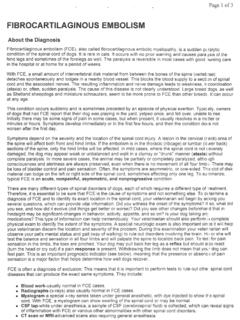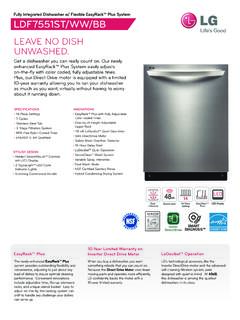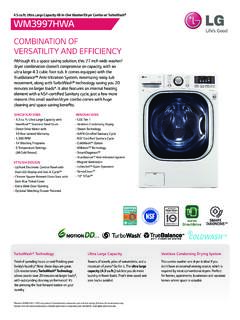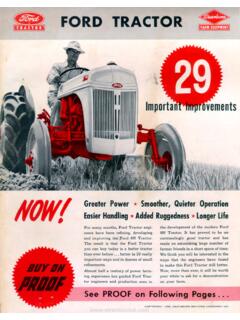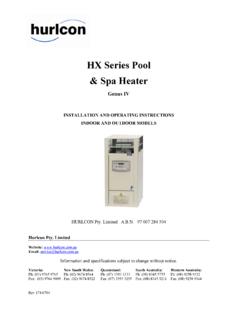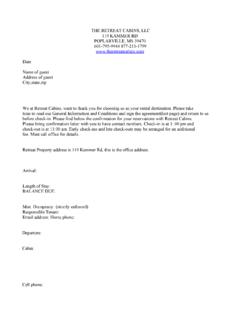Transcription of East Penn’s Recommended Evaluation Method and …
1 East penn 's Recommended Evaluation Method and Resource Guide for Motive Power Charging MOTIVE POWER BULLETIN. Today's motive power fleet has more options for charging than What is the right operation for Fast, ever before. Along with these additional choices comes an added Opportunity, or Conventional charging? responsibility to make sure these methods are best suited for each operational application. Traditional methods such as Conventional It depends! Each operation should be carefully evaluated before charging or newer ones like Fast or Opportunity charging can be any charging Method decisions are made. Below are some general an invaluable tool if used correctly in the right operation.
2 Claims of operational characteristics that can help determine if Fast, Opportu- substantial cost savings and productivity benefits associated with nity, or Conventional charging is right for the intended these techniques should be carefully evaluated and researched be- application. fore determining the best Method of charging. Fast Charge Compatibility: As a leading supplier of Motive Power products with over Operation is either 2 shifts, 8-10 hours per shift, or 3 shifts, 60-years experience in the battery industry, East penn feels a re- medium duty (2-4 hour run time per shift) using 2 batteries per sponsibility to our agents, sales network, and ultimately our truck with Conventional charging.
3 Customers, to ensure these faster methods of charging are imple- mented in the proper application that best serves our customers' User perceives significant value in reducing spare batteries and motive power operations. associated battery storage, charging, and change -out equipment. In order to determine whether Conventional, Fast, or Opportunity Battery power requirement for a 24-hour period will not exceed charging is right for an operation, it is imperative to compare the dif- times the 80% rated capacity of the battery. ferences of each charging Method . Minimum 6-hour charge time available per 24-hour period. Sufficient charge time for weekly full charge and equalize charge.
4 What is the difference between Conventional, Fast, and Opportunity charging? Opportunity Charge Compatibility: The main difference between charging methods is the rate at Operation is an extended single shift, 10-12 hours, or 2 shifts which the battery is charged. Fast and Opportunity charging with a light to medium workloads, five to six days per week. charges a battery at a higher rate than Conventional charging. User perceives significant value in reducing spare batteries and Fast and Opportunity chargers deliver a higher charging rate when associated battery storage, charging, and change -out equipment. the battery is at 30 to 80 percent state of charge because the Battery power requirement for a 24-hour period will not battery's charge acceptance is higher.
5 This significantly reduces exceed times the 80% rated capacity of the battery. charging time. Below is a chart listing the various charging Minimum 12-hour charge time available per 24 hour. methods and starting rates: Sufficient charge time for weekly equalize charge. Charging Method Charging Starting Rates Conventional Charge Compatibility: Fast * 31 - 60 amps per 100 AH Single and multiple shift, light to heavy-duty operations, Opportunity ** 21 - 30 amps per 100 AH where a battery is used for one shift Conventional 16 - 20 amps per 100 AH Material handling equipment is utilized 80% or greater per operation shift * The maximum start rate Recommended Material handling equipment with attachments requiring by East penn is 40 amps per 100 AH excessive battery power such as large clamps, slip sheets, ** The maximum start rate Recommended and extended mast heights by East penn is 25 amps per 100 AH.
6 Extreme environmental operations such as freezer or Fast and Opportunity charging are very similar. The biggest differ- high temperature ence between the two methods is the start rate of the chargers. They both require that the battery is charged during break periods and downtime while still in the material handling equipment. Conventional charging has a lower charging start rate. It is de- signed to fully charge the battery after it is discharged to 80% of its rated capacity. The discharged battery is replaced with a fully charged battery allowing the lift truck to remain in use. 1. If you are currently using Conventional charging Electrolyte level and temperature sensors and are considering a change , what critical Vented battery tray design questions need answers when evaluating Forced air cooling systems Fast or Opportunity charging systems?
7 Material handling equipment upgrades may also add If an operation matches the Fast or Opportunity compatibility re- significant cost to the equipment: quirements previously mentioned there are still many critical ques- Mounting brackets for connectors tions that should be considered when evaluating a faster charging Additional jumper cable leads system. It's important to note that all operations can work with Con- Cooling fans on battery compartment ventional charging as long as there are sufficient batteries and chargers available to support each operating shift. New safety gear required at each park and charge location is also a cost that cannot be ignored: 1.
8 Will a Fast or Opportunity charging system provide sufficient power for peak demands? Eye wash stations Protective gear Batteries on a Fast or Opportunity system are seldom completely charged. Skipping breaks or downtime needed for charging is Fire extinguisher not an option, and will result in an ampere-hour deficient battery. Ventilation equipment These batteries will not perform at rated capacity or provide ac- 6. How much extra space is gained with ceptable service at this lower state of charge. Fast or Opportunity Charging? 2. Budget available for replacement batteries? Many operations that switch to Fast or Opportunity charging Additional funds will need to be allocated for more replacement eliminate their room dedicated for battery charging to save space.
9 Batteries over a shorter period of time. Immediate productivity They eliminate the need for spare batteries and change -out equip- needs should be compared to the cost of more replacement ment, which can also save considerable space. batteries to determine the most cost effective charging solution. In most cases, however, a designated battery area with extraction equipment is still required to facilitate battery repairs, 3. Will there be time saved at down periods like break time? maintenance, or change -outs. The cubic space of the battery Claims of shorter downtime at break periods are extremely charging room verses the cubic space of the park and charge lo- relative to the operation.
10 With Fast and Opportunity charging, cations should also be considered. the time the material equipment operator takes to park the equipment, connect the battery to the charger, and walk to the What is the best way to evaluate break area must be examined. Although a battery change -out may charging Method compatibility? seem longer, a properly designed and installed battery side extractor and racking system will require only 2-3 minutes. East penn has developed a Charging Evaluation Process and A Conventional charging battery change -out can actually take Power Solution Development Method . With this Evaluation process, less time depending on the location of the park and charge East penn works step by step with the customer to determine the location within a Fast or Opportunity charge operation.
